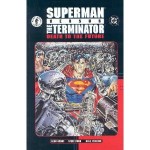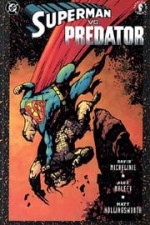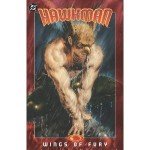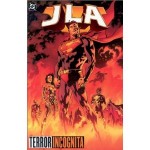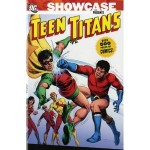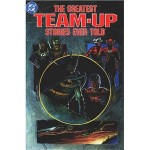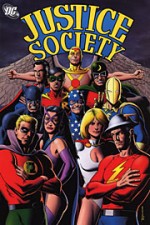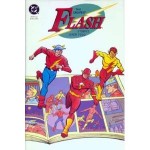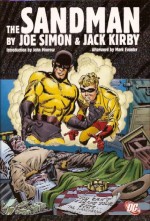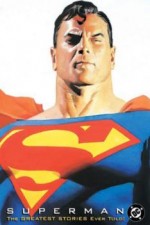
By Jerry Siegel, Joe Shuster &various (DC Comics)
ISBN: 978-1-4012-0339-9
When graphic novels were just establishing themselves as a separate collector commodity in the late 1980s DC launched an ambitious series of themed hardback compendiums celebrating the “Greatest Stories …†but after far too few spectacular tomes the project was shelved (see The Greatest Team-Up Stories Ever Told for a perfect example). The title was revived in the early 2000s in a sleek, stripped down form and continues intermittently to this day, exclusively focusing on individual heroes and titles.
One of the first of these new collections featured the Big Gun who started it all and this compelling array of fantastic adventures is as intriguing for what’s omitted as it is enticing for its included contents – all selected (presumably) by editors Dan DiDio and Anton Kowalski.
After an effulgent and enticing introduction from writer/producer Michael Uslan the action begins with Jerry Siegel and Joe Shuster’s ‘The Origin of Superman and his Powers’ from Superman #1, June 1939; a raw and captivating treat matched in energy and simplistic enthusiasm by the two-page feature ‘What if Superman Ended the War?’ from the tabloid Look Magazine (February 1940) wherein Hitler and Stalin, instigators of that distant “second European War†were hauled off to the World Court by the irresistible Man of Tomorrow.
Once America joined the melee Superman was constrained to be far more circumspect…
There’s a big single bound to July/August 1950 for the next selection as the Man of Steel met a trio of outlaws from his destroyed homeworld in the action-packed clash ‘Three Supermen From Krypton’ (Superman #65) courtesy of writer William Woolfolk & Al Plastino and another jump to October 1962 and issue #156 for ‘The Last Days of Superman’ by Edmond Hamilton, Curt Swan & George Klein – a tense and terrifying thriller which employed the entire vast and extended supporting cast that had evolved around the most popular comicbook character in the world.
Next up is a classic confrontation between the Caped Kryptonian and his greatest foe in ‘The Showdown Between Luthor and Superman’ (Superman #164, October 1963) by Hamilton, Swan & Klein again – possibly the ultimate 1960s creative team – pitting the lifelong foes in an unforgettable confrontation on a lost world of forgotten science and fantastic beasts.
Julie Schwartz breathed fresh life into the franchise when he became editor in 1971, spearheading controversial and socially challenging material unheard of since the feature’s earliest days. From Superman #247 (January 1972) came a groundbreaking yarn by Elliot Maggin, Swan and Murphy Anderson which questioned the hero’s effect on human development and self-reliance in ‘Must There be a Superman?’
The legendary Jim Steranko was one of a host of stellar creators who contributed to the anniversary Superman #400 (October 1984) and his lavish op-art illustrated prose treatise ‘The Exile at the Edge of Eternity’ explored the Last Kryptonian’s legacy throughout space and time, after which that same issue provided an enchanting pin-up from France’s greatest export. Moebius.
When DC Comics decided to rationalise and reconstruct their continuity with Crisis on Infinite Earths they used the event to regenerate their key properties. The biggest shake-up was Superman and it’s hard to argue that the change was unnecessary. The old soldier was in a bit of a slump, but he’d weathered those before. So how could a root and branch overhaul be anything but a marketing ploy that would alienate real fans for a few fly-by-night chancers who would jump ship as soon as the next fad surfaced?
Superman’s titles were cancelled/suspended for three months, and boy, did that make the media sit-up and take notice – for the first time since the Christopher Reeve movie. But there was method in this corporate madness…
Man of Steel, written and drawn by John Byrne and inked by Dick Giordano stripped away vast amounts of accumulated baggage and retuned the hero to the far from omnipotent edgy but good hearted reformer Siegel and Shuster had first envisioned. It was a huge and instant success, becoming the industry’s premiere ‘break-out’ hit and from that overwhelming start Superman returned to his suspended comic-book homes with the addition of a third monthly title premiering the same month.
The miniseries presented six complete stories from key points in Superman’s career, reconstructed in the wake of the aforementioned Crisis. ‘From Out of the Green Dawn…’ (Man of Steel #1, June 1986) revealed a startling new Krypton in its final moments then followed the Last Son in his escape, through his years in Smallville to his first recorded exploit and initial encounter with Lois Lane.
Byrne was a controversial choice at the time, but he magnificently rekindled the exciting, visually compelling, contemporary and even socially aware slices of sheer exuberant, four-colour fantasy that was the original Superman, making it possible and fashionable to be a fan again, no matter your age or prejudice. Superman had always been great, but Byrne had once again made him thrilling and unmissable.
Two years later Byrne, with artists Mike Mignola & Karl Kesel, brought the saga full circle in ‘Return to Krypton’ as Thanagarian heroes Hawkman and Hawkwoman ferried the Metropolis Marvel to the debris field that was once his birthworld in search of a spiritual connection to his lost forebears – an eerie epic first published in Superman volume II, #18, June 1988.
Every comic-book is a product of – or at least reaction to – the times in which it was created. In the morally ambiguous America prior to 9-11 Joe Kelly wrote an issue of Action Comics (#775, March 2001) which addressed the traditional ethics and efficacy of ultimate boy-scout Superman in a world where old-fashioned values were seen as a liability and using “The Enemy’s†own tactics against them was viewed with increasing favour by the public.
Illustrated by Doug Mahnke & Tom Nguyen, ‘What’s So Funny about Truth, Justice and the American Way’ introduced super-telepath Manchester Black and a team of Elite metahumans who acted proactively with extreme overkill to global threats and menaces in such drastic and brutal manner (like The Authority they very much resembled) that Superman was forced to take a hard look at his own methods before triumphing over “heroes†who saw absolutely no difference between villains, monsters or people who disagreed with them…
After closing with this solid reaffirmation and comforting proof that no matter what the times dictate, the core principles which shaped the founding father of superheroes remained unchanged and unchanging, this first magnificent meander down memory lane concludes with the ever-popular creator biographies section – and my perennial quibble that it would be nice to have included a few relevant cover images included…
Every generation has its favourite Superman. Hopefully this selection offers the potential new fan and veteran collector a few opportunities to reconsider which one that might be – or even expand their purview. It’s probably wisest to just love them all.
© 1939, 1940, 1950, 1959, 1962, 1963, 1972, 1984, 1986, 1988, 2001 DC Comics. All Rights Reserved.

